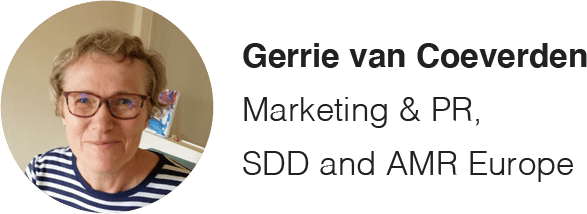FROM TRUCKDRIVER TO 3D PRINTER OPERATOR

When truck driver Ronald van Huffelen became the victim of an accident, he thought he would never find a job again. Read below how he found is new job as a 3D printer operator.
Cooperation between Lucrato and SDD
Due to a work-related accident, Ronald was unable to do this work as a truck driver anymore and he unwillingly ended up at home. This he experienced as extremely frustrating and undermining. He did not have the slightest idea what kind of work he was able to do, no more than what he wanted to do.
Ronald came into contact with Lucrato. Lucrato is a government-subsidized entity that works for the municipalities of Epe, Apeldoorn, and Heerde. It helps and guides people who are jobless because of physical or other disabilities, in their search for a fulfilling job. The power of Lucrato is the ability to see the talent of the people they help and not their disabilities. Within their network, they look for a company or institution that matches best the person they are trying to help.
And so Ronald joined up with SDD in Ernst (belonging to the municipality of Epe). SDD is a distributor of print finishing solutions: they assemble and distribute binding, cutting, and folding machines. SDD is a progressive company, willing to create new jobs when necessary and desirable.
During the time that Ronald was looking for a suitable job, SDD-subsidiary AMR Europe was just trying to fathom the 3D printer: find out what you can do with a 3D printer and how to deploy it in favour of your production process. Subsidiary AMR Europe has sold and distributed 3D printers since 2015.
Press Trim Module
Now we need to bridge the gap to the Press Trim Module (PTM). The PTM is a module sold worldwide by SDD to major printer companies such as Canon, for inline use behind their production printers. The PTM contains 72 components, which SDD previously had made by suppliers.
An example of a component is a part with conical holes, made out of POM (polyoxymethylene, a very strong plastic). The cost of making this part used to be very high.
The supplier made use of subtractive production techniques: sawing, cutting, milling, and drilling.
Causes for the cost-ineffective production were:
- Small production series
- Laborious product
- Expensive material
- High amount of material used by the supplier
3D printing as an alternative production method
Because of the small annual amount needed, SDD started to look for an alternative way to produce the above component.
The alternative was: 3D printing, also called additive manufacturing. Production series below 3000 items make 3D printing profitable.
Ronald proved to be the ideal person for SDD to operate 3D printers. Ronald found it exciting to learn something new but also stressful at times. However, he persisted and has worked as a 3D print operator for almost two years now. He communicates with his superior about the work for the day every morning and prints 2000 components every month. Ronald thrives at SDD and is happy that he has a job close by.
Advantages of 3D printed components
SDD produces most 3D-printed parts with ABS-A100 (acrylonitrile butadiene styrene). This is a material SDD was awarded HB certification for. (HB stands for Horizontal Burning Test and gives information about the flame resistance of a material).
ABS-A100 is strong, abrasion-proof and very useful for 3D printing.


Further advantages of 3D printing for SDD are flexibility in material, flexibility in design, and the ease of prototyping new components.
Last but not least, the 3D printed components give less wear and tear in the machines than the subtractively manufactured POM components.
For questions, email: info@amreurope.com